35025 Brocklebank Line
The long road to restoration
Brocklebank Line was withdrawn from BR service on 1st September 1964 and arrived at Woodham's scrap yard in 1965, along side around 200 other locos. Over the following 30 years most of these locos were sold to a range of preservation groups and left Barry for destinations across Britain. A small number were cut up in 1980, and 35025 was lucky to escape - it was next on the list for the gas axe. It had survived 21 years in the scrap yard, though like most of the others it lost its tender.
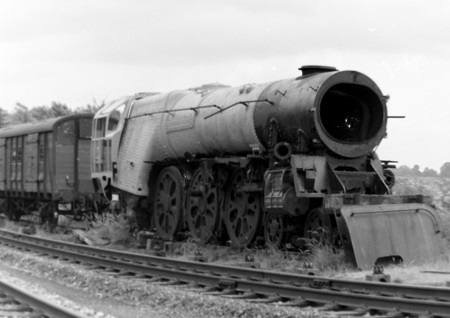 |
35025 at Rothley. Some cleaning and painting has been started on the boiler and cab. |
The Southern 8P Preservation Group, led by Keith Marshall, bought the loco for £7,850, and paid a further £1,200 to have its asbestos lagging removed by a specialist contractor. The loco was the 169th to leave Woodhams, in February 1986, moving to the Great Central Railway, in the long siding of Quorn yard. The Brocklebank Line Association was formed, and in 1988 it moved with PMV S1153S, which the was purchased as a tool/sales stand store to the stub siding south of Rothley Station, which was to be its home for four years.
In 2005 the GCR gave the Association notice to quit; it eventually moved to Sellindge in 2007, but not before a burglary at the Loughborough parts store which led to the loss of many valuable pieces, few of which were recovered. Facilities at Sellindge were minimal, funding and support wained, and little progress was made. A plan to sell the loco to the Churnett Valley Railway came and went. In 2019 the Association's chairman, Brian Seddon, approached SLL with a view to the loco passing to the company. Agreement was reached and 35025 became part of SLL's fleet, adding a Merchant Navy almost 15 years since SLL had sold Port Line.
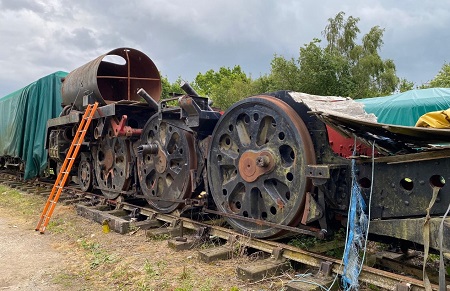 |
SLL's first 35025 working party at Sellindge was on 14th June 2020. |
SLL's immediate mission was to secure the loco and components, and to clear the site to enable access. Restoring a large loco in a field is not a viable plan in the 21st century, and at some point the loco must be moved to a covered location where it can be secure, and ultimately restored. However a large team of volunteers has come forward, many of whom had previously worked on Eddystone at Sellindge, and progress has accelerated. Much of the initial work was to clear the overgrown site of vegetation, dumped cars, etc. The frames needed to be moved to a place from which the loco could eventually leave the site, and a third container was acquired to serve as a workshop.
There's a new photo gallery showing work at Sellindge from 2020 onwards here and the gallery of 35025 in BR days is here.
Please note, the most recent updates come first.
December 2021 update
Regular volunteer session during 2021 have transformed our site; vegetation cut back, accessible level sites for the frames, a new insulated container. The frames have been lifted off the wheels, allowing access to the back of the wheels and the axle boxes. The boiler has been inspected and found to be in remarkably good condition considering that it was last steamed in 1964. We've acquired a grit blaster from a local company and our neighbours who are scaffolders have offered to build 'tents' around the frames for the grit blasting, all funded locally.
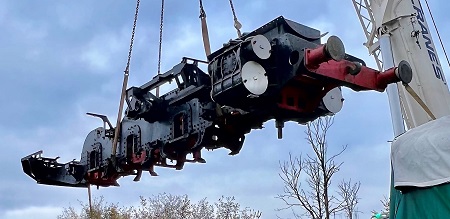 |
11th November was the 'big lift' day when Brocklebank Line's frames were lifted into their new position. |
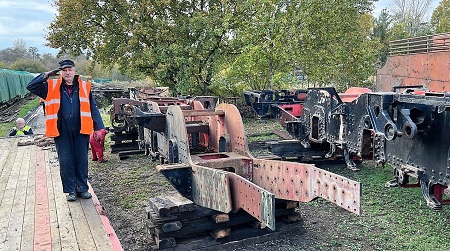 |
Long-serving SLL volunteer Mike Price salutes the arrival of Sidmouth's frames (left) and Brocklebank's (right) |
November 2021 update
Much has changed at Sellindge in the last year despite Covid-19. The site has been much improved by groundwork and new facilities, and our work has moved on from conservation of what SLL acquired to the start of serious restoration of 35025, which will also include work on 34010 Sidmouth.
Terry Dorrity has come up with a superb photo of 35025 Brocklebank Line and from his book "Way Down South: Southern Steam in the Sixties".
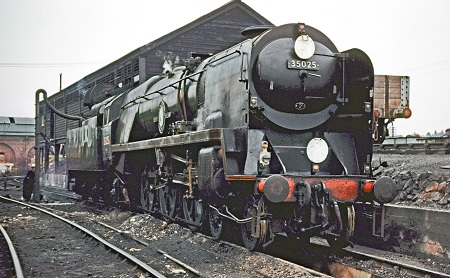 |
Brocklebank Line taking on water in front of the coaling stage at Salisbury shed (72B) on Sunday 4 June 1961. Photo: Terry Dorrity |
The gallery is short of images and we'd very much welcome any photos of 35025 in BR days. If you have any please contact the Webmaster at nicksidmouth@gmail.com
Meanwhile Richard Green of locos-in-profile.co.uk has produced one of his fine prints featuring 35025. The print shows it as running after May 1960, with speedometer, and with cut-down tender 3350. Copies of this are available, without charge, to those making a new SLL share application.
|
We were also pleased to hear from Richard Derry with a contribution towards the restoration of Brocklebank Line. Many will recognise his name as the author of the popular series 'The Book Of' covering many locomotive classes. Currently he is amending his book of the West Country and Battle of Britain classes with new information which has come to light since first publication in 2002.
Site improvements
A local Hiab owner has moved the smaller items on site to make way for the various parts of Brocklebank Line to be brought nearer to our 'workshops' by a heavy crane. Two Pullman bogies have been removed so that we can transfer our boiler to the same area for easier access for the low-loader to remove it for overhaul, when funds permit. We are arranging the transfer of Sidmouth's frames, but we need to have moved Brocklebank Line's first as they will sit behind Sidmouth's, as the latter's will be moving off site first. It's impractible to arrange for Sidmouth's frames to arrive on the same day as Brocklebank Line is lifted, so this will be undertaken the week after the main move.
|
Mike Price has converted the front of both the original SLL and the Brocklebank container into work areas with benches, vices, etc and we're gradually transferring the huge amount of parts in '25's container to the newly cleared SLL one so that we can ascertain exactly what we have. This is easier said than done bearing in mind the weight of Merchant Navy parts and the enormous age of some of the team. It has been most rewarding to find many parts buried under literally tons of other parts which would have cost a small fortune to manufacture, and whilst the job will still be enormous, we have never had such a good start to a restoration.
Our two 40-foot storage containers have been the subject of many man hours to clean out (one clearly hadn't been opened for many years!) so that we can see exactly what we have, at the same time as setting up a workshop in one, whilst the surrounding areas continue to be cleared of undergrowth and made safe to work. Skips have been arriving on site and much removed. Plans are now in hand to move the locomotive to a more accessible position near our containers which will require a very large crane and lowloader, the cost of which will be shared with the arrival of more stock on site by other Owners.
|
Some minor moves took place on 21st September and a large crane is planned for November for Brocklebank Line and the 19th for Sidmouth's frames
There is a limit to what can be accomplished in a field with temporary covered accommodation, so we were pleased when our cladding team at Swanage offered to rebuild Brocklebank Line's cab, which is looking rather sad having been open to the elements for 20 years.
|
Restoration work
Working parties paused in January and early February as much due to the bitter weather as Covid restrictions. They are now back in full swing at least once a week and we expect, as Covid restrictions ease, the size of them will increase. Having stripped all of the brake rodding and various items which had been reinstated 15 years ago, we are now dropping the main driving springs and releasing the bogie and trailing truck prior to lifting the frames. Many parts have been found which we were not aware of including three sets of newly tyred class 40 diesel wheels which we sold to a good home. These were bought for the proposed tender but as with our four other new build tenders proper Bulleid Firth Brown wheels will be utilised.
|
We now have weekly working parties dismantling Brocklebank Line and undertaking all the jobs which in the past have been on scrapyard wrecks. A lot of work was done on the loco in the past but for the last 15 years it's been exposed to the elements. One team is removing all the paintwork, firstly from the wheelsets, which are now thoroughly clean and paint free. Undercoats are now being applied. Others have been dismantling the brake gear which appears to have been re-pinned and re-bushed. The next job will be to remove the driving springs - not an easy job to do in a field with no proper lifting equipment. We're not sure if the springs were new or refurbished but all will have to go away for checking.
|
Following the excellent report from the inspector we have taken steps to further protect the boiler. With the current exception of the lower extremities, every square inch of the boiler has been wire brushed with angle grinders to ensure a smooth and rust free surface for the extremely expensive silver paint being applied. As soon as our first consignment of grit arrives the first job will be to blast the underside of Brocklebank Line's boiler.
|
The team have continued to not only dismantle the locomotive, but also transfer the smaller parts to our friendly gritblasting company near Canterbury. All the main driving springs were dropped in May and the locomotive is now jacked up sufficiently so that the frames can be lifted. Both the bogie and trailing truck can then be removed for dismantling, inspection and overhaul if necessary. A two day operation will see all the component parts of Brocklebank Line placed near our workshops with Sidmouth's frames end on to '25's and in the easiest position to collect when ready to return to Herston. The boiler will also be moved from its current position and placed for easy transportation, hopefully to the North Norfolk Railway when the time comes.
|
It would be really useful to talk to anyone at Loughborough who was involved to establish the facts about some of the work done in the past and some of the parts we've found. We believe there was also a set of West Country tender frames owned by the Association but despite extensive searching these haven't yet emerged from the undergrowth at Sellindge. The only real expense we have upcoming at Sellindge is crane and lorry hire to move the locomotive from its current position to a newly cleared area close to our containers.
The area in the boiler between the outer and inner firebox has had its first washout in 56 years. Sharpened sections of rebar had to be used to break the concrete like substance which had formed since BR had dispatched the locomotive to the scrapyard - clearly not giving it a washout after its last weeks in service. It took several hours of high pressure spraying before the sludge was removed via the mudhole doors and following a couple of further hours work we're sure it's now cleaner than it's been in over half a century, and ready for the next visit by our boiler inspector. Following a recent visit by an NDT specialist we are awaiting their report which we understand could confirm that the boiler is in remarkably good condition compared to many that came out of Barry.
|
Some of the original Brocklebank Line supporters have very kindly bought shares in SLL which has enabled us to get essential supplies such as decent sleepers to stand the cab and smokebox on, and eventually '25's frames, new tools and vast amounts of primer, undercoat, and new paint for the boiler. The NDT examination costs were also covered by shareholders and it seems from the report that we don't have too much to worry about, although we await the second inspection by our new boiler inspector who looks after the Spa Valley locomotives. We do know that we have to replace the front tubeplate owing to water build up behind it while at Barry and the angle it was put at on arrival at Sellindge, but the NDT specialist was optimistic about the condition of the firebox. Hopefully the inspection will prove him correct as the condition of the boiler is always crucial in a restoration project.
|
October 2020 update
Since the first working party in June all wheels have been stripped down to bare metal and the first coat of primer applied. All the brake rigging has been marked up and removed and is now in secure storage. The smokebox has been removed and awaits derusting and primering. The sand boxes have been removed as have most of the running plates, all of which will be off by November.
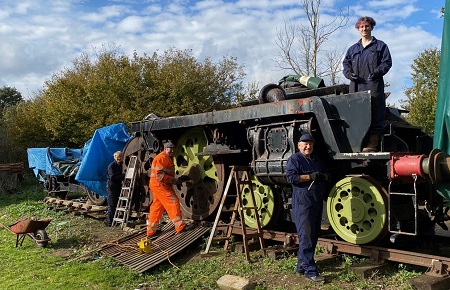 |
Weekly working parties have cleared the jungle that surrounded the loco and are dismantling and cleaning parts. |
The boiler which has been thoroughly cleaned inside and out with the small amount of rust removed from behind the tubeplate. It has had its NDT and MPI testing and all was more than satisfactory. We await the final boiler inspector's report advising work which will be necessary to return the locomotive to traffic.
The next job will be to lift the frames off the drivers and moved to a position near our newly refurbished containers, one of which has been partly converted into a workshop for the Winter. We will be laying a 60 foot length of track on which the bogie, driving wheels, frames and trailing truck will be lined up. The tender tank which looks to be in reasonable condition after so many years outside will be placed behind on sleepers, whilst the boiler will be lifted out of its current position and placed adjacent to the frames.
The area next to our containers is kindly being cleared by the landlord so that the cab and smokebox can be placed next to them. We will therefore have the entire kit of parts in a small area within easy reach of our 'workshop'. We are running weekly working parties as a minimum, normally on Tuesdays, but these can be flexible. There is much non-skilled work to do at this stage as we have an enormous amount of parts which have to be stripped of paint and/or derusted and then primered, etc. We are looking at costs of possibly having our own grit blasting facility at least on a temporary basis owing to the volume of parts. Please contact Simon on southernlocos@btinternet.com if you would like to help.
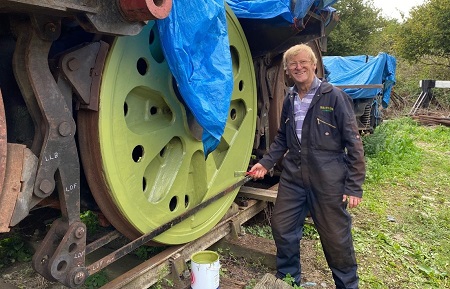 |
The brake linkages have been carefully numbered and are being removed. |
While SLL's board and supporters would like to see 35025 running we are conscious of the scale of the project. Our initial commitment is to conserve the loco and its parts and to get the site into a manageable condition. Restoration would have a six figure price tag, and SLL has existing overhaul and restoration commitments. However if the level of support we have seen so far remains, we can continue to undertake the initial stages of its full restoration.
June 2020 update
The initial tasks some of which have already started, led by Richard Moffatt, are:
Accumulated debris and rubbish cleared from around the loco.
Life expired protective boarding and sheeting removed and disposed of.
Vulnerable journal surfaces cleaned and regreased or Denzo applied.
Peeling/insecure paintwork - commenced cutting back to bare metal and priming.
Axlebox Lubrication carried out and hornguides flooded with oil.
Middle engine eccentric (in position) accessed and lubricated.
Smoke Box sand boxes removed and placed into store.
Lower slide bars left and right, inner and outer removed, cleaned, oiled up and placed into store.
Brake rigging treated with diesel to free up prior to removal to store.
Small storage area for hand tools etc set up in SLL 40' parts storage container.
New protective sheeting deployed on loco to provide future weather protection.
Looking further ahead the plans include:
Cut back deteriorated paintwork and apply new protective coating, to include wheels and frames where access possible.
Remove Brake rigging, repaint and place in storage.
Remove smoke box and repaint.
Remove middle and trailing sand boxes and place in storage.
Consider jacking up loco to enable inspection of Driving/leading and trailing truck axleboxes.
Check all driving axle centring dimensions against setting out standard.
Carry out complete updated inventory of parts in 40' storage container.
Clean down and repaint, cab, boiler and tender tank.
...plus an absolute myriad of other tasks - but the above will do for starters.
